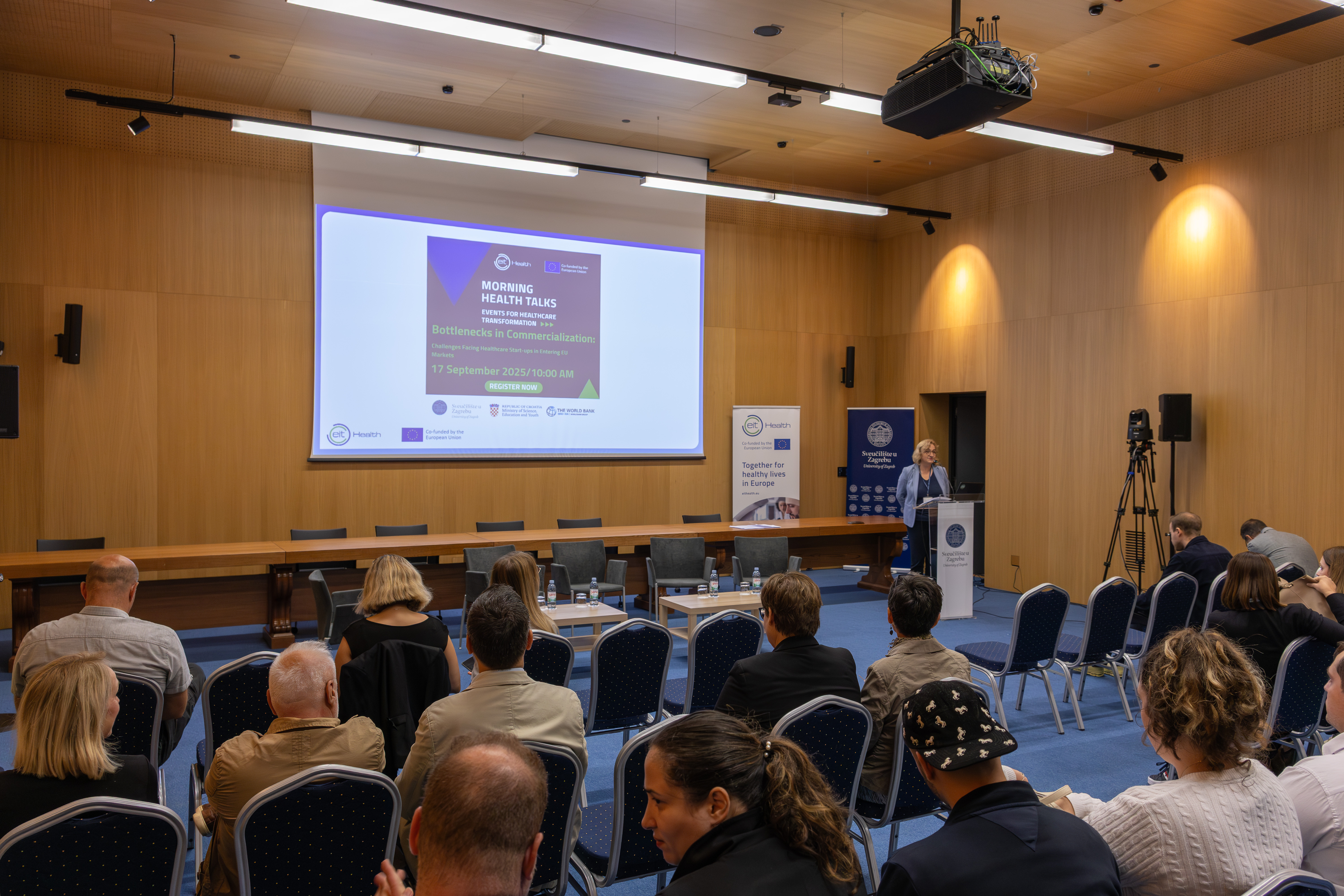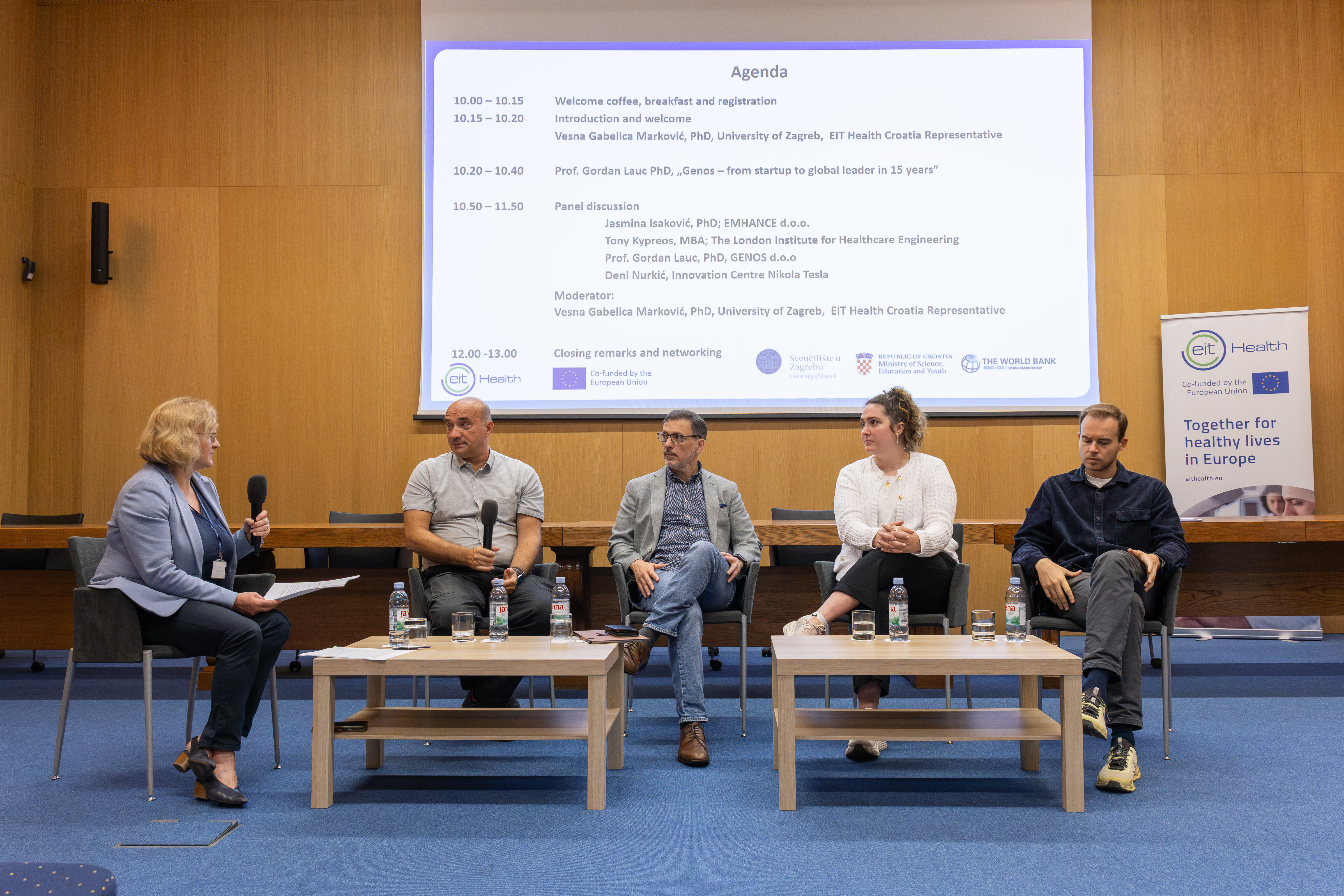26th September 2025
17 September 2025 – The Autumn edition of the EIT Health Morning Health Talks series started in Zagreb (Croatia), under the title “Bottlenecks in Commercialisation: Challenges Facing Healthcare Start-ups in Entering the EU Market.” The discussion highlighted the persistent difficulties healthcare start-ups in Central and Eastern Europe (CEE) face when entering markets, particularly when targeting EU markets. Encouragingly, the panel identified practical solutions. Four key obstacles highlighted by panellists to hinder the commercialisation of health innovations were: fragmented EU healthcare markets; outdated laws and regulations; limited access to capital and risks with investments.
Fragmentation in practice
Jasmina Isaković (EMHANCE d.o.o.) highlighted that healthcare systems in the EU are various, and as a conclusion, healthcare markets are fragmented. In CEE countries, the markets seem to be simple because healthcare systems are centralized, acting with one main buyer, which is the National Health Insurance. However, outdated legislation and reluctance to adopt innovations in healthcare pose obstacles. By contrast, expansion in Western parts of Europe requires navigating far more complex ecosystems. For instance, in Germany, negotiations mean numerous healthcare insurers and providers. At the same time, the UK operates on a strongly evidence-based model that demands extensive expertise and strict documentation, something many CEE start-ups are unprepared for.
Translators, Mentors, and Smart Scaling
Solutions begin with acknowledging knowledge gaps. “Know what you don’t know, and use expertise,” was the mantra echoed throughout the discussion. Tony Kypreos of the London Institute for Healthcare Engineering highlighted the emerging role of translators—professionals who bridge the worlds of research and market by turning R&D results into commercially viable products. Tailored, one-to-one mentorship and partnerships with organisations like EIT Health and the European Innovation Council (EIC) can also help start-ups scale efficiently and identify realistic target markets.

Solutions: Translators, one-to-one Mentorship, Scaling
The answer to the fragmentation can be summarized as “know what you do not know” and “use expertise”. Identify your knowledge gaps regarding the markets you plan to enter and be brave for work with experts. Tailored one-to-one mentoring is highly effective. Organizations like EIT Health and the European Innovation Council (EIC) are good partners in it. Tony Kypreos (London Institute for Healthcare Engineering) highlighted the importance of a specialized expertise that is still relatively new in the CEE: translators. These professionals play a crucial role in commercialization, bridging the gap between research and markets. With their multidisciplinary knowledge, translators transform R&D outcomes into viable, market-ready products. Whether or not a start-up chooses to embrace a translator, scaling innovations, and identifying realistic target markets remains essential for sustainable growth.

Financing: A Persistent Barrier, Virtual Share, Blended Financing
The lack of capital is a frequently cited challenge among healthcare startups. In CEE, structural obstacles keep away the investor interests. Investors avoid small markets and restrictive regulatory environments, but an even greater barrier is that venture and angel investors show little interest in early-stage or small-sized companies – precisely the profile of most start-ups in CEE. As a result, an early-stage company often needs to attract 20–30 investors to secure sufficient funding. The good news is the changing landscape: today, there are already around 5-10 venture funds in the CEE willing to invest in early-stage biotech and Medtech start-ups.
Deni Nurkić (Innovation Centre Nikola Tesla) pointed out, even when teams reach the stage of investor negotiations, they often resist agreements regarding ownership and decision-making rights of the investors. To address this gap, virtual share offers a possible solution. This construction was launched in Croatia not long ago. Under this model, investors do not participate in the decision-making process. However, after a defined period and once the company reaches a certain maturity level, the virtual share transforms into a real share—complete with voting rights and profit sharing. This approach can be effective in university–start-up relationships, where early-stage development often relies on university capacities. It ensures that academic institutions receive recognition for their capacities. For angel investors, the model is less attractive, as they typically demand oversight and influence for their investment.
To bridge this investor gap, blended financing is emerging as a promising pathway for biotech and Medtech startups. Blended financing combines public resources (from governments, NGOs, or development banks) with private capital to support projects with significant social or environmental impact, but less appealing to commercial investors due to slower returns or higher risk. Such schemes often include risk-mitigation mechanisms, such as guarantees or first-loss protection provided by the public partner. Given the longer payback periods and conservative market dynamics of healthcare, blended financing can be a good tool for enabling start-ups to survive and grow through their most critical development phases.
Key value: People
The role of people cannot be overstated. Prof. Gordan Lauc, Ph (GENOS d.o.o.) noted that success is built on hard work and dedication, the result is having reputation. Equally important is winning the support of key opinion leaders and establishing effective relationships within the ecosystem in which the startup operates. The value of these connections is immeasurable.
Tony Kypreos (London Institute for Healthcare Engineering) emphasized that to shape market need, startups should engage with potential clients as early as possible. One effective approach is to build relationships with organizations where potential clients are concentrated—such as patient groups or professional medical associations. Additionally, integrating into supportive structures like Centers of Excellence, incubators, or accelerators allows start-ups to complement their own skills and capacities with additional expertise and resources.
Number one advice
What is the number one advice for young entrepreneurs who aim EU healthcare markets? The panelists agreed that there is no ready-made example to simply copy. The most critical factor is people. It is essential to build a strong team and relationships with the right experts, stakeholders, key opinion leaders, CEOs, etc. to work with. Knowing who knows what and who can help when it is needed. Start-ups should leverage networking and involve themselves in their ecosystems. Success cannot be achieved alone; connections are the key.
Find out where the EIT Health Morning Health Talks are heading next.
Hospital Clínic study reinforces patient participation as key to digital health innovation

New work published in Journal of Medical Internet Research.
Help shape the future of digital health assessment – take part in the EDiHTA survey

Take part in the EDiHTA survey.
AI health start-ups lead Europe’s push for competitiveness in healthcare innovation

European AI healthcare start-ups remain competitive.